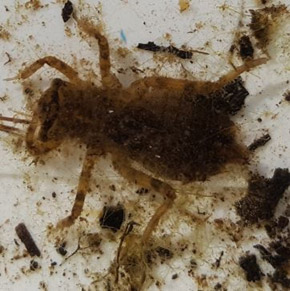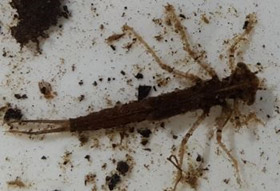West Lake is home to many aquatic macroinvertebrates – small organisms without a backbone that are large enough to be seen without the use of a microscope. In any bucket of water you may scoop from the lake, lots of life can be found. Some aquatic macroinvertebrates are known to be sensitive to pollution and will not live in water tainted by chemicals. The diversity of species found in West Lake reflects the fact that West Lake is a largely unpolluted lake. Let’s take a closer look at the common types of aquatic macroinvertebrates found within the lake.
Dragonflies & Damselflies
You may be familiar with dragonflies and damselflies. These insects and many others start their life cycles in the water. They start out as eggs and then grow into nymphs in the water. They can be found underneath leaves and burrowed in sediment in calm water.
|
Photo: A dragonfly nymph hiding among algae and sediment. After completing metamorphosis, this nymph will become a club-tailed dragonfly (family: Gomphidae) that will glide above the lake hunting for mosquitoes and gnats. Photo courtesy of Dr. Jon Bossley. |
Photo: A damselfly nymph showing its much narrower body compared to the dragonfly nymph. The appendages at the end of the abdomen are gills, which the damselfly uses to extract oxygen from the water. Photo courtesy of Dr. Jon Bossley. |
For additional information about dragonflies and damselflies, please check out the following links:
Mother Nature Network – a site explaining physical differences between adult dragonflies and damselflies
http://www.mnn.com/earth-matters/animals/blogs/how-tell-difference-between-dragonfly-and-damselfly
Learn About Nature – information about dragonfly habits and life cycles
www.dragonfly-site.com/dragonfly-life-cycle.html
Life in Freshwater.net – a website that includes photographs of dragonfly nymphs and information about their life habits
http://lifeinfreshwater.net/dragonfly-nymphs-odonata-anisoptera/
Life in Freshwater.net – a website that includes photographs of damselfly nymphs and information about their life habits
www.lifeinfreshwater.net/damselfly-nymphs-odonata-zygoptera
Caddisflies
Caddisflies are another species of insect that begins life in the lake. There are many different types of caddisflies, each with a unique set of physical traits and life habits. Some caddisfly larvae are free-living and crawl about under rocks and among leaves that fall into the lake. Others build tube-like cases for themselves to protect their bodies as they develop. One caddisfly family known to inhabit West Lake is Leptoceridae – the long-horned case makers. These caddisflies are so-named because they build a protective cone made of sand particles or plant material around their bodies.
Photo: currently unavailable
For additional information about caddisflies, please check out the following link:
BugGuide.net – identification page providing photos of adult caddisflies www.Bugguide.net/node/view/11600
Snails
A variety of snails call West Lake home including wheel snails, pouch snails, and gilled snails. Wheel snails are appropriately named for their round shell that forms a concentric spiral. In contrast, pouch snails and gilled snails have a spiral, cone-shaped shell that tapers to a point. All snail shells have an opening called the operculum from which the soft-bodied snail can extend when grazing or retract into when disturbed. Pouch snails have an opening on the left side of the shell when the point of the shell is held upright. Gilled snails have an opening on the right side of the shell when the point of the shell is held upright. The distinction between pouch snails and gilled snails can help indicate water quality. Pouch snails can carry oxygen with them underwater. This trait makes them tolerant of stagnant water and even polluted water that is low in oxygen. Gilled snails, on the other hand, get oxygen from the water through their gills. Consequently, they require well-oxygenated waters and are intolerant of pollution. Gilled snails are found commonly in streams where the moving water readily mixes with the air to provide a continual supply of oxygen. Pouch snails are found commonly in ponds and lakes such as West Lake, where the non-flowing water is often lower in oxygen.
Photo: currently unavailable
For additional information about aquatic snails, please check out the following links:
Freshwater Molluscan Shells – an informational website providing photographs and identification tips on pouch snails
Freshwater Molluscan Shells – an informational website providing photographs and identification tips on gilled snails


